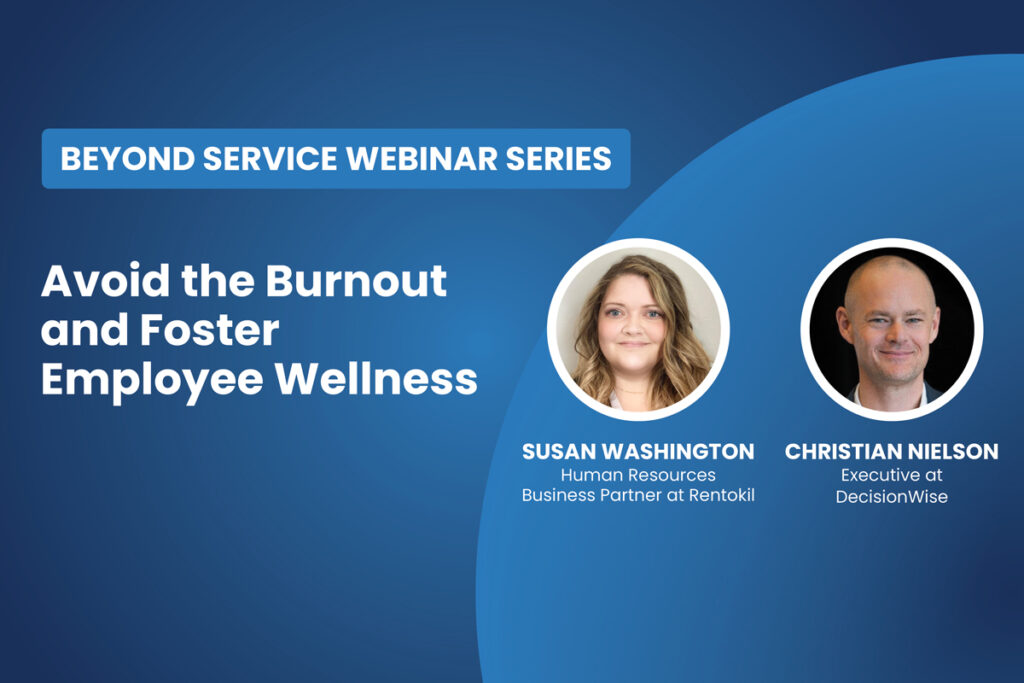Research shows that two-thirds of employees say they have experienced burnout at some point in their career, and 36% of workers say their organization doesn’t have the resources available to combat burnout.
The fourth webinar in the Slingshot Beyond Service series delves into this common challenge faced by many in today’s fast-paced and demanding work environment. Burnout can lead to decreased productivity, increased absenteeism, and even physical and mental health problems. Fostering employee wellness is important for not only the individual employee but also for the overall success and productivity of a company.
Rentokil’s HR Business Partner, Susan Washington, and DecisionWise Executive, Christian Neilson, joined us to explore and educate us on various industry practices that can help employees avoid burnout and promote their overall well-being. By implementing these strategies, organizations can create a positive and supportive work culture that helps employees thrive.
According to a live poll, we discovered that
- Only 52% of the businesses who attended currently measure employee engagement via Employee Net Promoter Score (eNPS) or another survey
- 39% of the businesses that attended had instances of “quiet quitting” in the last 6 months.
- 60% of the businesses that attended said that employee wellness ranks in their company’s top 5 initiatives for 2023.
These metrics hold value to the fact that many businesses recognize the problem of employee burnout and want to make changes, but they simply lack effective tools and strategies to do so. Let’s get a good understanding of where burnout stems from and learn some actionable prevention and remediation tools to implement immediately.
Burnout is All the Buzz
Burnout has no boundaries
The burnout struggle is real, but what’s causing it all? For one, the labor shortages many of us are experiencing simply can’t keep up with consumer demand, and now everyone has more work on their plate. “The labor shortage has left more work for everyone to do. Now a worker may be doing three people’s jobs instead of one.” A few other reasons include:
- Lack of information and support from the organization
- The disparity of workload across teams
- Constant change
- Acquisitions and operational changes
- Internal and external stressors
Is “Quiet Quitting” New?
When employee engagement goes off the rails
“Quiet quitting” is essentially when employees disengage and put in the bare minimum effort. Susan tells us, “There’s a gap between what an employee is willing to do and the value that they perceive the company is bringing to them. When you have this gap, a symptom is either quiet quitting or resignation.” Many workers quietly quit (or actually quit) when they feel that the company doesn’t support their needs, and for many of us, a crucial need is a work-life balance.
Shifting Employee Concerns
What do your employees care the most about?
It’s important to know what your employees care about so that as their employer, you can meet their needs and encourage a productive and positive work environment. These overall needs have shifted from year to year. For example, in 2020, studies showed that employees were most concerned about health and safety, productivity, and collaboration, whereas, in 2022, they were more concerned with flexibility, workload, and mental health. Regardless of why these concerns have shifted, companies need to take action if they want to keep their workers happy about coming to work every day.
Ways to Measure Burnout
Keep a pulse on what’s going on
One of the first steps in addressing burnout is being able to identify it. There are several ways to measure burnout, including eNPS surveys, turnover, and a Net Belonging Score. You can also get a general sense of how employees are feeling by having regular, open conversations with them about how they’re doing. You’ll get a sense of whether they feel overwhelmed or satisfied with their level of achievement if there are internal or external stressors and more. It’s important to regularly check in with employees and assess their well-being to identify any potential issues.
You Can’t Pour From an Empty Cup
Importance of priorities, managers, and goals
If you are a manager or leader in your company, you need to take care of yourself just like everyone else. You can’t give to others when you’re depleted of energy, positivity, self-care, etc. Set clear goals and expectations for the team and provide support and resources as needed.
- Lead by example
- Take time off
- Schedule send emails
- Go out on a field visit
- Spend time connecting with others
Importance of Core Values
Being connected to a deeper sense of purpose
As Viktor Frankl says, “Those who have a ‘why’ to live, can bear with almost any ‘how.’” Are your company’s core values living and breathing throughout your business? Are they being communicated on a consistent basis? Leaders need to be competent in downstream communications, and employees who understand the purpose—the ‘why’—are much more willing to put effort toward their workload because they’re much more passionate about it.
The further down a person is from the top—whether it’s the CEO, owner, founder, etc.—the more important it is for them to stay connected to a direct manager that they enjoy working with. People don’t leave companies, they leave managers. Managers are the company to the colleague. If managers are aligned and connected to the company vision, then so will the employees.
My Employees and I Are Already Feeling Burnout, Now What?
Burnout has already set in, and you’re past the prevention phase
There are several tools and programs that can help employees cope with burnout and promote overall well-being. These can include things like leadership and management training, stress management training, and employee assistance programs. Offer and encourage employees to take advantage of these resources, and make them easily accessible. Remediating burnout needs to come from three different parties: Executives, Human Resources (HR), and the manager and team levels.
- Hire a Mindfulness Consultant
- Prepare Wellness Webinars periodically to stress the importance of mental health, financial wellness, seasonal depression, and more.
- Normalize meditation and breathing exercises
- Job Analysis Quadrant
- Helps identify areas where employees may be misaligned
- Perceived bureaucracy areas
- Gray areas of responsibility that need to be clarified
- Identify potential burnout concerns
- Take Control
- Put focus time on the calendar
- Block exercise time
- Meetings audit
- Gain Time Back in Your Day
- Implement a third-party answering service to help you and your employees gain more time to do all of the things that support employee wellness
- Slingshot is a resource to help you improve your work-life balance, all while increasing sales and productivity
- Create Opportunities for Employees to Socialize and Connect
- People thrive in environments where they’ve made friendly connections with those around them
Conclusion
In conclusion, burnout is a common issue faced by many employees, but it can be prevented with the right strategies and practices. By regularly assessing employee well-being and health indicators, setting clear goals and expectations, providing support and resources, and fostering a sense of engagement and connection among employees, organizations can create a positive and supportive work culture that helps employees thrive. At Slingshot, we’re your number one supporter for creating this type of work environment, and we’ll partner with your company to make it happen. Don’t hesitate to reach out to schedule a time to talk!



